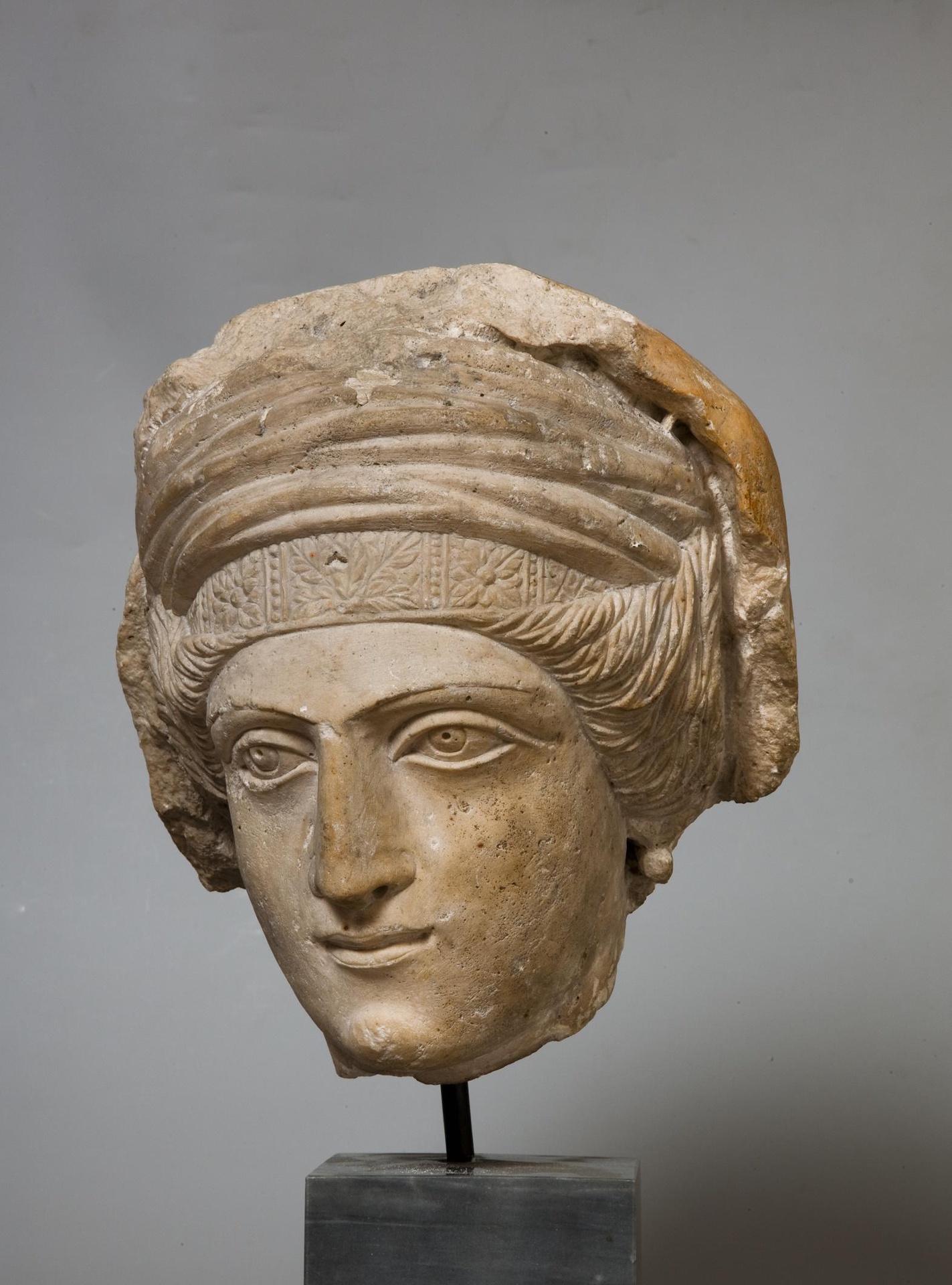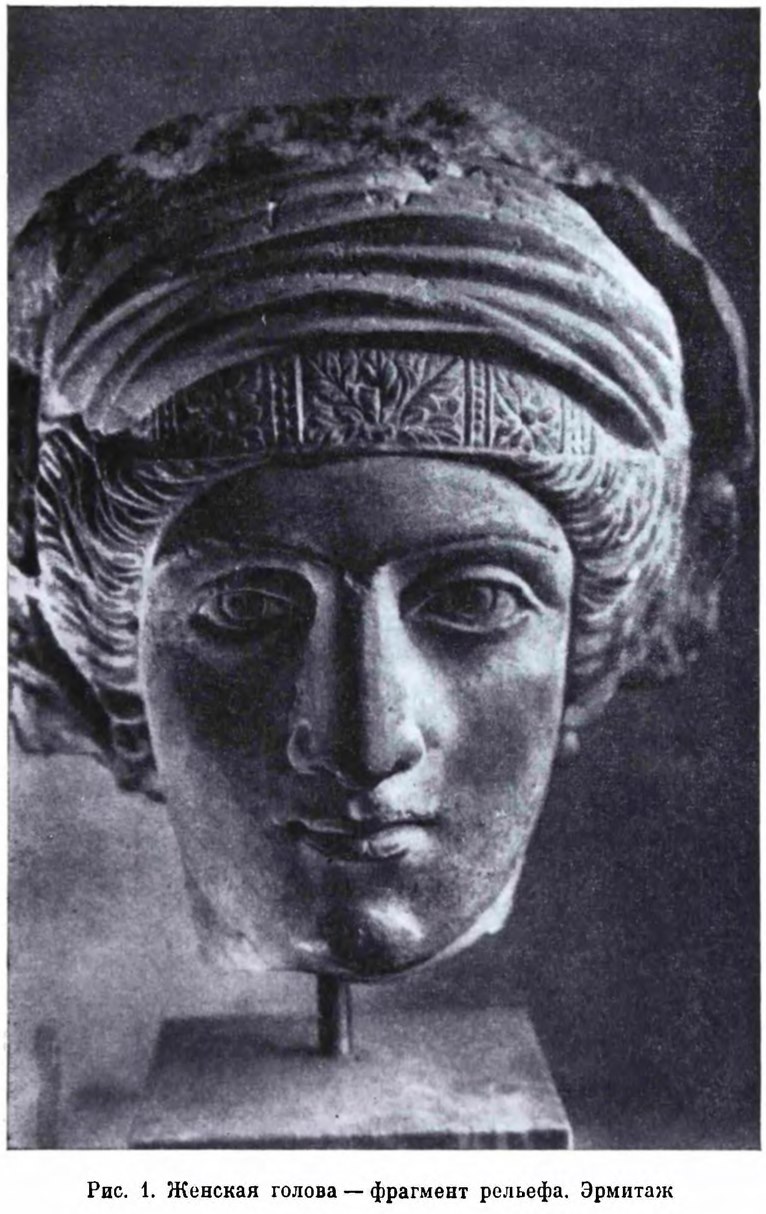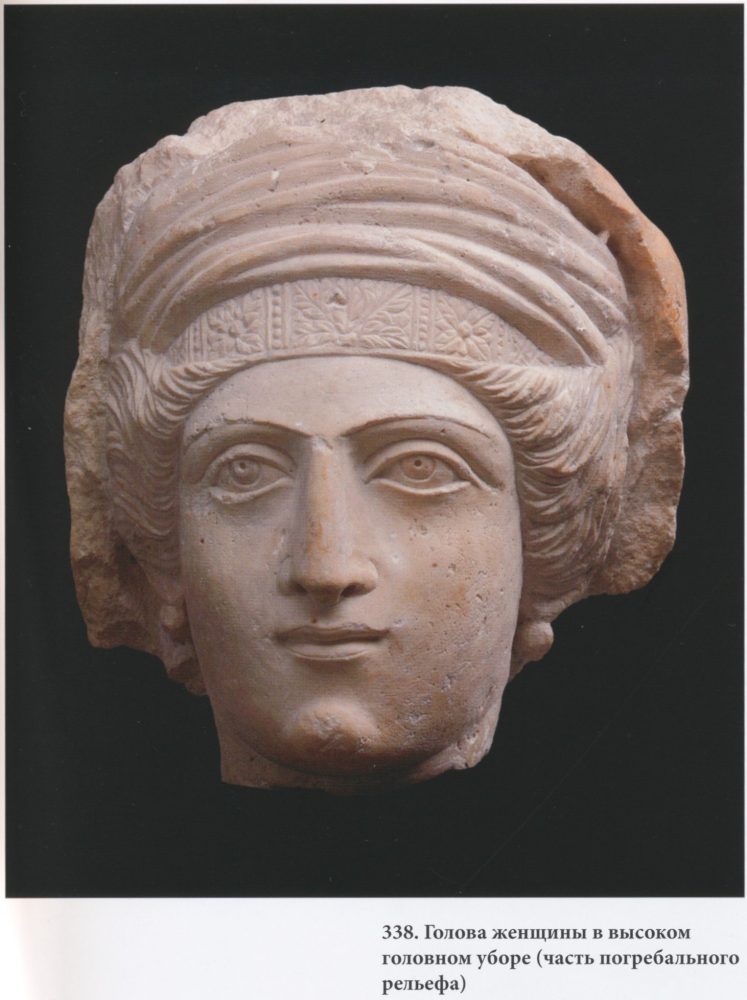


Рис. 1. Женская голова — фрагмент рельефа.
Эрмитаж.
“Among the Palmyra portraits of the Hermitage there is a remarkable female head – a fragment of a tombstone . [1] The head, as is usual for Palmyra portraits, is slightly less than life size. The woman’s forehead is decorated with an ornamented forehead, over which a headband is laid in beautiful folds. Soft wavy hair is pulled up from the sides and tucked under a headband. There are small round earrings in the ears. The woman has an oblong oval face and regular, almost classic features. To designate individual details, engraving was used: the contour of the lips is outlined, the eyebrows are drawn, the circle indicates the iris of the eye (Fig. 1 ).
The face of an unknown woman amazes with its special sophistication, sophistication of appearance. This is reflected in the elongated oval of the face, smooth line of long eyebrows, gracefully outlined lips, almond-shaped eyes with heavy eyelids. In other words, the portrait has the charm of individuality.
It is curious that in this portrait the sculptor, as it were, combined two different approaches to depicting a person: in the interpretation of the face of the face, he paid tribute to classicist tendencies, while in the profile drawing he emphasized the individual characteristics of the person portrayed – a sloping forehead, dimples in the corners of the mouth, a small chin protruding forward.
Initially, this portrait was in the collection of the famous collector and traveler S.S. Abamelek-Lazareva. He gave the first publication of the monument in the form of a photograph. [2] In the work of A.I. Voshchinina [3], the portrait is briefly mentioned as an example of Palmyra sculpture of the 2nd century, in which an element of idealization is felt, coming from the traditions of Hellenistic art.”
“The portrait of a woman in the Hermitage is a brilliant example of the fusion of local artistic tradition with the influence of the portrait art of Rome. The high quality of the work made it possible to show on it all those features of Palmyra portrait art that seem to us to be characteristic of the period of the 60-80s of the II century.”
I.I. Saverkina
Palmyra portrait of the Hermitage collection.
// CA. 1968. No. 3. S. 206-210.
И.И. Саверкина
Пальмирский портрет собрания Эрмитажа.
// СА. 1968. №3. С. 206-210.
http://kronk.spb.ru/library/saverkina-ii-1968.htm
WOMAN’S HEAD IN HIGH HEADDRESS – FRAGMENT OF FUNERAL RELIEF.
[exhibition catalog]
Collection of the RAIK Museum in the Hermitage.
// Exhibition catalog. St. Petersburg: State Hermitage. 1994.248 s.
Antiquities from Palmyra. ( E.V. Zeimal ) http://kronk.spb.ru/library/1994-spb-raik-2.htm
Second half of the 2nd century – the beginning of the 3rd century.
B. 0.23.
A woman’s head in a high “turban” (however, it is possible that the folds of the traditional for Palmyra female reliefs bedspreads), with a ribbon-diadem on the forehead (divided by vertical stripes of “pearls” into several “compartments”: in the center – a wide, filled with acanthus leaves; on the sides of it, symmetrically, there are two square “compartments” with “rosettes “In them; from the next two” compartments “fit only the very edge). From under the “turban” and the diadem, one can see (left and right) hair, indicated by twisting, receding strokes, “gathered” in weakly expressed “strands”. The hair almost completely covers the ears: only the lowermost parts of the lobes with small globular earrings are visible. The superciliary arches are sharply expressed and seem to hang over the eyes; the eyebrows are only outlined by a narrow relief fold (without cutting into “hair”). The eyes are large, wide open, elongated almond-shaped; the raised iris does not reach the lower eyelid; the pupil is transmitted by a deepened “dot”. The nose is straight, regular in shape, with a slight hump below the bridge of the nose and with small wings. The cheeks are softly modeled plastically, the cheekbones are only outlined, the nasal folds are not shown. The mouth is small, ideally well-defined (the contour is worked out in relief), the upper lip is much narrower than the lower one. The chin is rounded, slightly protruding forward.
The upper part of the relief (above the “turban” and on the back side) is not processed; the surviving fragment (ie, at the level of the neck and above) does not show the usual traces of transition to the “background” slab; it is unlikely that it began below the neck, rather, the head belonged to one of the figures in the composition on the lid of some sarcophagus.
This head is undoubtedly the best example of the art of Palmyra sculptors in the period when Roman influence was most pronounced in the Hermitage collection. But here, too, the portrait is clearly idealized (albeit in the Hellenistic-Roman traditions), which does not allow us to talk about the reflection of character and, even more so, about the “intentness and alertness of the gaze” and that the configuration of the mouth expresses “arrogance and mental fatigue” … It is better to refrain from such subjectivity in assessing and interpreting the Palmyra sculptural portrait: sometimes it is enough to change the lighting in which the relief is studied (or photographed) in order to make sure that the features and properties attributed to the image are imaginary quantities.
State of preservation: the nose on the right and the cheek on the left are damaged, potholes, the back wall is broken off.
Literature: Saverkina, 1971, pp. 26-27 . Ill. 32 .
[ Also see: Abamelek-Lazarev 1997 , tab. XVII ) ]
Inv. No. 8848.
Head of a Woman in a High Headdress (Fragment of a Palmyrene Funerary Relief)
Created: Palmyra. 2nd century
This female head is wearing a tall “turban” with a headband-diadem across the forehead. The hair emerging from beneath this headwear is indicated by wavy lines running backwards that are gathered in weakly indicated strands. The hair almost completely covers the ears: only the very bottoms of the lobes are visible with small globular earrings. The brow ridges are prominently sharp, the brows themselves indicated only by a narrow relief fold. The eyes are large and wide open with an elongated almond shape. The iris, indicated in relief, does not reach the lower lid. The pupil is marked by a small indentation. The nose is straight and regular, with a slight bump below the bridge and narrow sides. The cheeks have been modelled with a plastic softness; the cheekbones are barely indicated; the nasal folds are not show at all. The mouth is small, its outline ideally regular. The upper lip is significantly narrower than the lower one. The chin is rounded and slightly protruding.
Material: limestone
Dimensions: height: 26 cm
Acquisition date: Entered the Hermitage in 1927; transferred from the Museum of Anthropology and Ethnography of the Academy of Sciences
Inventory Number: ДВ-3925
Palmyra artifacts in the Hermitage >> Museum website
http://artyx.ru/books/item/f00/s00/z0000023/st004.shtml
